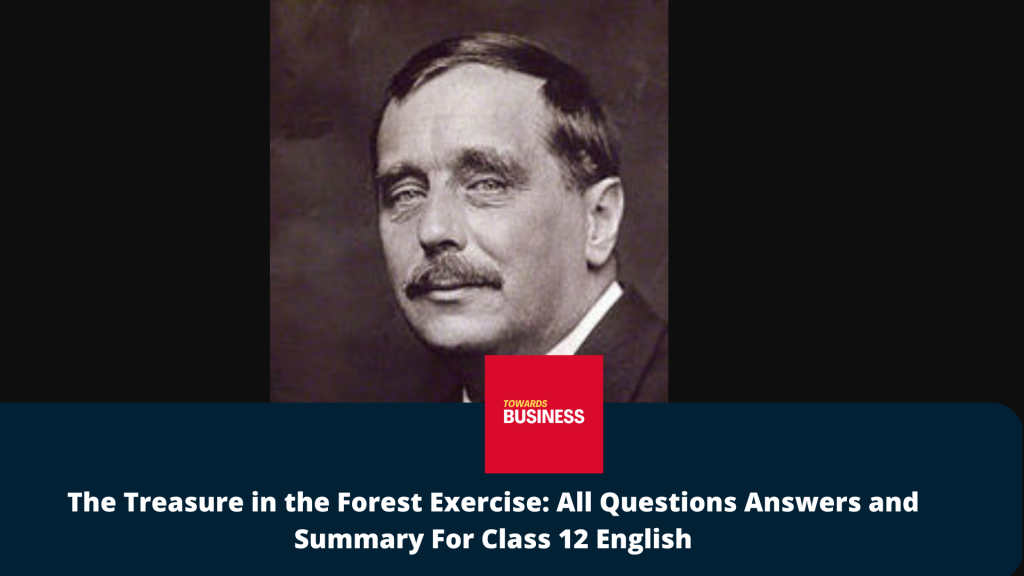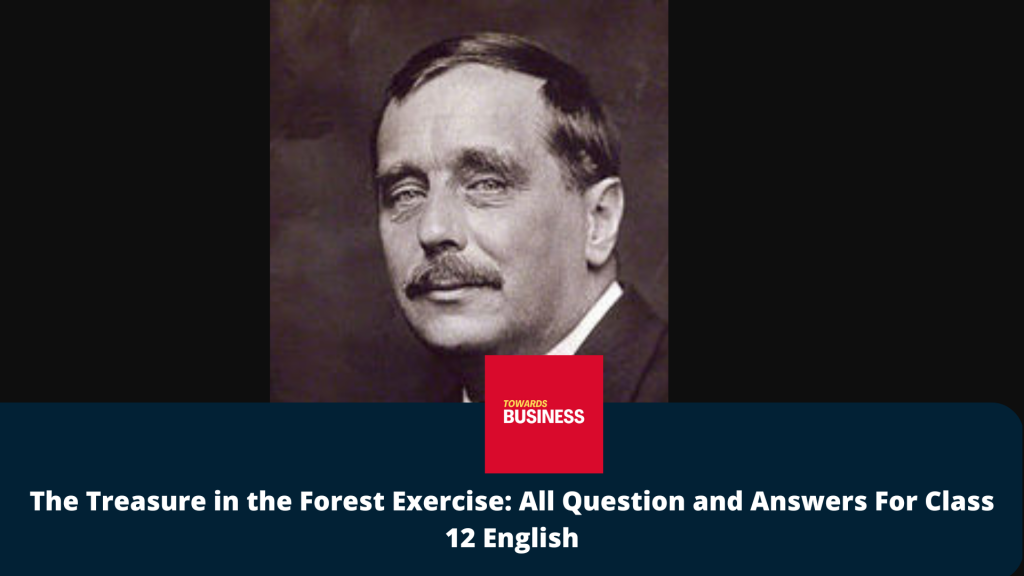“The Treasure in the Forest” was written by H.G. Wells. “The Treasure in the Forest” is an ominous adventure story in which two men search for Spanish treasure, letting greed get the better of their awareness. The narrative continues to demonstrate how power and greed corrupt human beings.

In this article, we’ve listed all the question answers as well as the summary of “The Treasure in the Forest” exercise as part of the class 12 English curriculum. Here is the table of contents:
- The Treasure in the Forest Exercise: All Question and Answers For Class 12 English
- The Treasure in the Forest Exercise: Reference to the Context For Class 12 English
- The Treasure in the Forest Exercise: Reference Beyond The Text For Class 12 English
- The Treasure in the Forest: Summary For Class 12 English
The Treasure in the Forest Exercise: All Question and Answers For Class 12 English

Listed below are all the questions and answers for “The Treasure in the Forest” exercise for Class 12 English.
a. Describe the expository scene of the story.
The narrative begins with two treasure seekers, Evans and Hooker, approaching the land in a canoe. They see a little river running into the sea, a denser and deeper green forest, a sloppy hill, and the sea.
b. What does the map look like and how do Evan and Hooker interpret it?
The map appears to be crude, with separation-causing creases and wear. Evan interprets the map’s wavy lines as the river and the star as the location, whereas Hooker interprets the dotted and straight lines as the route to the lagoon.
c. How did Evan and Hooker know about the treasure?
➜ Evan and Hooker knew about the treasure from the conversation with the Chinese man and the map he has.
d. Describe Evan’s dream.
Evan had a dream about the treasure and Chang-hi. In their dream, they were in a forest and came upon a little fire that had three Chinese guys sitting around it conversing quietly in English. Despite working alone and keeping it a secret, he needed assistance now to get the gold. Chang-hi was brutally murdered by them after a battle.
e. What do the two treasure hunters see when they walk towards the island?
As they go towards the island, the two treasure seekers notice three palm trees of bushes at the mouth of the stream.
f. In what condition did the treasure hunters find the dead man?
The deceased guy was discovered by the treasure seekers laying in a clear space between the woods, his hands and ankles bloated, his neck puffy and purple. The body of a Chinese man was in a miserable state.
g. How did the treasure hunters try to carry gold ingots to the canoe?
With the aid of a coat whose collar was caught by the hands of Hooker and Evan on either end, the treasure hunters attempted to bring gold ingots to the canoe.
h. How were Evan and Hooker poisoned?
Because of their negligence, Evans and Hooker were poisoned. They lacked the necessary understanding regarding the pointed dots at the bottom of the map. Evans initially became poisoned within the pit while touching gold bars. Twice, he got the lethal thorns of Dyak in his fingers.
As Hooker picked up the final gold bar, he encountered the same thorn in the flesh. The poisonous thorns started showing their reactions. Both felt pain in their arms and necks. They trembled in pain and died at last.
The Treasure in the Forest Exercise: Reference to the Context For Class 12 English
Listed below are the answers to the ‘Reference to the context’ part of The Treasure in the Forest.
a. How do you know the story is set on a tropical island?
The story “The Treasures in the Forest” has been set on a tropical island. The story opens with Evans and Hooker, two men who had traveled all night from the mainland, paddling a canoe towards a coral island in the heat of the midday sun.
Tropical islands are known for having a variety of ecosystems that are naturally unique to them, including tropical rainforests, open woodlands and grass savannahs, freshwater lakes and streams, salt marshes and mudflats (wetland), mangrove and coastal forests, sefis, fringing and offshore coral reefs, and deep sea.
As the narrative unfolds, we see a canoe approaching the shore in the opening scene, followed by descriptions of the bay, the white waves of the reef, the littered river, rushing to the sea, the untamed forest, sloppy slope, etc. The atmosphere, ecosystems, lusher forest, freshwater stream coastal forest, palm trees, prickly shrubs, seagrass, and depth of the sea all serve to inform the reader that the novel is place on a tropical island.
b. Why do you think Evan and Hooker took such a risk of finding the buried treasure on a desert island?
I believe Evans and Hooker accepted the risk of discovering the hidden wealth on a barren island because of the following factors:.
- Due to their avarice, they took this risk.
- Treasure hunts aid in the development of new abilities as well as the improvement and reinforcement of existing ones, including leadership, communication, and problem-solving. Both employers and employees will gain equally from this.
- This benefits both employers and employees equally.
- It cultivates the capacity to handle any challenging situations.
- They could be successful and wealthy.
c. Do you think the narrator of the story is racist? If yes, what made him feel superior to other races?
Yes, I find some sort of racist feelings in the narrator of the story ” The Treasure in the Forest” when he presents. Evan and Hooker as superior to that of the Chinese man in the story. When we use the term “racist,” we refer to someone who treats people of different races unfairly and discriminates because they don’t share their beliefs.
According to the narrative, Evans and Hooker viciously murdered the Chinese man. Have you lost your senses, Hooker asked Evans? This statement also displays Hooker’s domineering behavior with Ivan. As a result, the narrator of the story is implied to be a racist frequently in the narrative.
d. What do you think is the moral of the story?
The lesson of the fable ” The Treasure in the Forest” is that people tend to grow more selfish as they pursue greed and power. As they learn more about the treasures, Evans and Hooker’s greed grows. They violently killed the Chinese guy Chiang-hi and then used the map to look for hidden treasure.
It is Greed that is the disordered desire for more than is decent, not for the greater good but for one’s own selfish interest, and to the detriment of others and society at large. Greed may be for anything, but it is most frequently for treasures and power, and power is much more harmful and can even result in someone’s death, as we see in the narrative.
The Treasure in the Forest Exercise: Reference Beyond The Text For Class 12 English
Listed below are the answers to the ‘Reference beyond the text’ part of The Treasure in the Forest.
a. Interpret the story as a mystery story.
H.G. Wells’ “The Treasures in the Forest” is a mystery story involving two wastrels (neglected situation), the dead body of a Chinese man, and thorns that draw blood in Hooker’s thumb. It carries many suspenseful instances such as:
- In the narrative, Evans, and Hooker, two treasure seekers, look for buried wealth in the forest.
- To obtain the treasure map, a hooker murdered Chang-hi, a Chinese guy. When he is killed, Chang-hi grinned at them.
- They paddle their boat toward the coral island. However, none of them is aware of its purpose.
- They follow the map and soon discover a forest, then a pile of stones just like the map. But then they find a man corpse of the Chinese man.
- Evans begins to help them get back into the canoe as soon as they spot the gold, but both of them are in excruciating pain.
- Hooker suddenly understands Chang-actual hi’s smile’s significance.
Thus, it is a mystery story.
b. Treasure hunting is a favorite subject of children’s stories. Remember a treasure hunting story you read in your childhood and compare and contrast it with ‘The Treasure in the Forest.’
Treasure hunting stories are so interesting to read. In my early years, I also read a story about finding treasure. The version of the story I read as a youngster was animated. That narrative was titled “Sindbad and the Treasure Island.” The main character Sindbad’s voyage on an enigmatic island, where he must confront different terrifying situations, is the subject of this tale of treasure hunting. I’m going to compare and contrast the tale of Sindbad with “The Treasure in the Forest” by H.G. Wells now. The following are a few examples of comparisons and contrasts:
- Both stories are related to treasure hunting and the sets of the stories are on islands.
- In “The Treasure in the Forest,” the explanatory scene begins with Evans and Hooker in a tiny canoe in the ocean, but “Sinbad and the Treasure Island” begins with Sinbad’s horse-mounted journey in the desert. Later, he builds his own sails for his boat.
- Hooker and Evans reach the island the next day of their voyage whereas Sindbad reaches the island after three days and nights.
- We find the search for water in both of the stories. Evans and Hooker get cold and fresh water in the middle of the forest and quench their thirst in the river whereas Sindbad drinks water in a huge spring.
- Evans and Hooker spend some time on the island walking and spot a body hidden behind some bushes, but Sindbad struggles with a variety of terrifying skeleton spirits and fights with them.
- Evans and Hooker find gold inside a hole just on the left side of the dead body. A map is also available. The wealth, however, is located by Sindbad in a cave on a mountain. Furthermore, he possesses a treasure map.
- At the conclusion of the tale, the deadly thorns claim the lives of both Evans and Hooker. Their lives are lost. At the last end, though, Sindbad calls his pals and carefully removes the wealth.
The Treasure in the Forest: Summary For Class 12 English

Here is the summary for The Treasure in the Forest.
Treasure in the Forest is a suspense story, depicted as a third-person narrative, relating the fate of two treasure hunters, Evans and Hooker who murder a Chinese man and steal his treasure map, which locates a buried stash of gold ingots (blocks of several valuable things).
The story begins with two characters Evans and Hooker who were heading towards a coral island in the heat of the noon sun, after having paddled all night from the mainland through the sea in a canoe in search of Spanish treasure.
Hooker is studying a map of the treasures, which the narrator reveals they have stolen from a Chinaman, Chang-hi, whom they murdered during the theft. Chang-hi had by chance discovered the treasure left behind by a shipwrecked Spanish galleon (ship), and had decided to rebury it elsewhere, at a location revealed by his map. They are very much tired and hungry as if they had no food to eat. They see the map and get puzzled by the dashes shown on the map. Evans and Hooker identify the spot indicated on the map, and after beaching their canoe they strike into the interior of the island, through the forest.
As Hooker is sailing the boat, Evans falls asleep and sees a little fire with three Chinese people sitting around it in his dream. They were discussing the Spanish treasure that a Chinese guy named Chang-hi had discovered on an island after being shipwrecked and wished to remove. They violently murder Chang-hi, a Chinese guy, and take the treasure map. He laughs at them as Chang-hi is killed. They paddle toward the coral island and are sailing there. However, none of them is aware of its purpose.
Following the map, they eventually come upon a forest and a group of stones that match the map exactly. However, they also discover a corpse of a guy with several bruises next to the purple and bloated body, which they believe to be Chang-employee hi’s who chose to take advantage after discovering the excavated pit and some riches.
The two men begin by loading Evans’ jacket with as much gold as they can carry back to the boat, but after traveling approximately 100 yards Evans’ arms begin to hurt, and he ultimately passes out. After Evans’s fall, Hooker rearranges the ingots on the jacket and feels a thorn puncture in his own flesh. It is only then that Hooker understands the actual significance of Chang-smile. Chang-hi had thorns “similar to those the Dyaks poison (native tribes of Borneo-blow pipes with fatal poison at its tip) and employ in their blowing tubes” to disguise his prize. The narrative comes to a conclusion as Hooker lies dying next to his friend’s “still quivering” body.
The Treasure in the Forest: Short Summary
“The Treasure in the Forest” is a foreboding adventure novel about two men who hunt for Spanish treasure while allowing greed to take over. As the plot progresses, we see how power and greed corrupt people.
The fundamental theme of The Treasure in the Forest is to avoid taking risks when we are unprepared. The two Englishmen took chances in a dangerous wilderness and were slain soon after. In this narrative, two Englishmen heard of riches on an island and received a map from a Chinese. After falling asleep aboard the boat, they paddled a canoe to the island. They navigated their boat across a lagoon and up a river in the forest, following the map and arriving safely at their objective.
When they found the death of the Chinese they had spoken with, they were shocked and began to worry about their safety, but nothing happened. Evans was packing the gold when he was punctured by the metal. Evans attempted to forget about it, but the fatal puncture led him to die briefly. Evans advised Hooker, the other man, to throw the faulty gold. Hooker, on the other hand, was terrified and didn’t comprehend what his companion said, and Hooker inadvertently touched the gold. Finally, both guys died.
This story excels in presenting the terrifying scenario when they faced the danger, and the result of taking the risk will bring attention to others.
